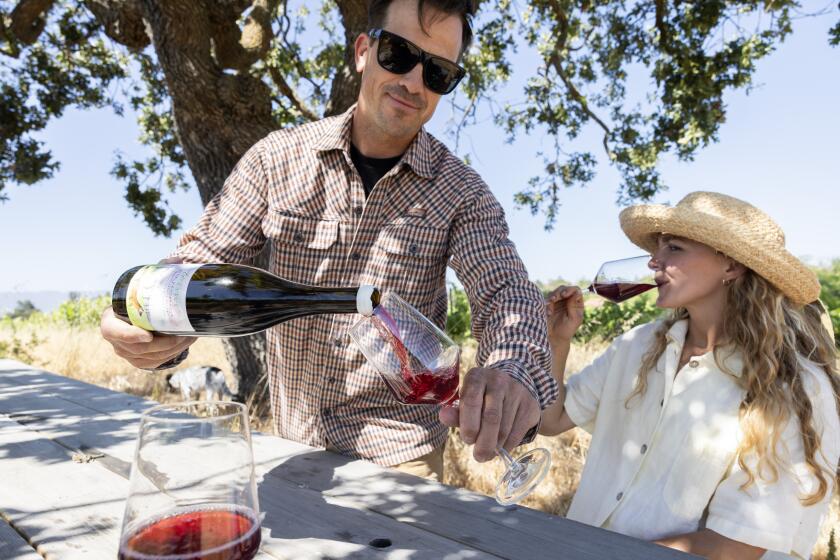Market Watch: Selecting the best grapefruit
Grapefruit may be the most misunderstood of California’s fruits. Excellent locally grown examples are available year-round at farmers markets, but it’s also easy to fall for fruit — often similar-looking and grown just a few miles away — that may be ludicrously sour or overmature. Choosing quality fruits depends on understanding the calendar of varieties and growing areas, which may seem inscrutable to the uninitiated but is easy to learn.
Grapefruit originated in the Caribbean, as a natural hybrid of pummelo and sweet orange, and needs virtually tropical heat over a long season to achieve a pleasing balance of sweetness and acidity. Also, unlike many fruits that do best when it’s hot during the day and cool at night, grapefruit does better when nights remain warm.
It’s therefore no surprise that more than half of the roughly 9,000 acres of grapefruit grown in California are in the torrid Coachella and Imperial deserts. Commercial growers start picking in November, when the fruit typically needs to be “sweated” with ethylene, a natural ripening gas, to remove its greenish tinge. This doesn’t do anything to remove the sourness, and honest growers will tell you that desert grapefruit doesn’t start tasting good until after Christmas.
Desert grapefruit is at its best right now, from January to March or April, and can still be good as late as May. Commercial growers pretty much pack it in by April, because the fruit gets soft and doesn’t ship as well. But for local and farmers market use, many growers prefer late-season grapefruit, because that’s when the fruit is at its sweetest.
Consumers vary greatly in their expectations of what a grapefruit should taste like. Some prefer them tart, some want them as sweet as possible (although grapefruit never get sugary sweet like an orange or mandarin), and some (myself included) like a balance of sweetness and acidity.
Desert grapefruit is one of Southern California’s greatest local specialties, which one might think would be much appreciated at farmers markets, but in fact it’s puzzlingly scarce there. Desert agriculture is mostly oriented to wholesale volumes, the distances are fairly great, and grapefruit vendors often ask modest prices, so the fruit is typically sold at farmers markets by date specialists, almost as an afterthought. Two desert farms that bring high-quality grapefruit are Robert Lower and Christina Kelso of Flying Disc Ranch in Thermal, at Santa Monica Wednesday, and Everett DaVall of Indio, at the Hollywood and Santa Monica Wednesday markets.
The San Joaquin Valley, with about a fifth of the state’s grapefruit acreage, comes next, starting in March and extending into May. Unlike oranges and mandarins, grapefruit has never become a major deal there. Because its season lags behind Florida, Texas and the California desert, it has to go up against the sweetest of their fruit.
Two grapefruit-like hybrids found in the valley, Oroblanco and Melogold, do mature much earlier, from November to February or March, because they are lower in acidity than conventional grapefruit. Robert Soost and James Cameron, citrus breeders at the University of California at Riverside, developed them by crossing Duncan, a seedy, flavor-packed white grapefruit, and Siamese Sweet pummelo, an acidless form of the mother species of the grapefruit. San Joaquin citrus growers commonly sell both at farmers markets. Oroblanco has a thicker skin, with a relatively small edible “fruit ball” inside, but superior flavor to its sibling.
These are just coming into prime season from Southern California growing areas such as the Inland Empire and northern San Diego County, and will be at their best in February through April. Look for large specimens, heavy in the hand, and bright light yellow, with little or no greenish tinge. A good Southern California Oroblanco is one of the tastiest choices for citrus in late winter.
Conventional grapefruit from Inland Empire areas such as Riverside, Redlands and Hemet are grown relatively close to the desert district, but across the mountains, and so their season is entirely different, harvesting in late spring and summer. Historically there have been few or no competing sources in the summer, so this was Southern California grapefruit’s time to shine. But imports from Southern Hemisphere producers such as South Africa are starting to challenge this predominance.
There is one combination of variety and growing area worth special mention: From late April into the summer, Star Ruby grapefruit, the most deeply pigmented of red varieties, is supremely delicious as grown in Pauma Valley, in northern San Diego County, where a touch of extra heat ripens them faster in spring. Like Napa Valley Cabernet or Sebastopol Gravenstein apples, Pauma Valley Star Rubys are grown at the perfect intersection of maritime and inland climatic zones. Look for them in season from Bob Polito, who sells at the Venice, Corona del Mar and Santa Monica Wednesday markets.
There are Southern California growers selling new-crop traditional grapefruit at farmers markets right now, even though they’re almost sour enough to substitute for lemons — some would say they’ll strip paint. But tastes differ: Carol Harriett of Thys Ranch, who was offering Star Rubys recently at the Torrance market, said “I can sell these all day long, and some customers just love the tartness.”
There are also some vendors who are still selling old-crop grapefruit, which started developing from flowers in spring 2009. Ultra-late-season grapefruit is only available from farmers markets and home gardens, and can be superbly sweet and flavorful at its best. But that best is typically late summer and autumn; by now old-crop grapefruit, even from the latest growing areas, like Ojai and other parts of Ventura County, is a real gamble. The pulp is often starting to break down, turn mushy, and develop musty off-flavors. Compare that to the firm but juicy texture, and fresh, clean flavors of desert grapefruit, and the lesson is clear: It’s time to move on.
That’s the glory of farmers markets: In a way that’s rarely possible at supermarkets, knowledgeable customers can learn the prime seasons for different varieties from specific growing areas, and obtain citrus at its best, or when it suits their tastes.
More to Read
Eat your way across L.A.
Get our weekly Tasting Notes newsletter for reviews, news and more.
You may occasionally receive promotional content from the Los Angeles Times.










